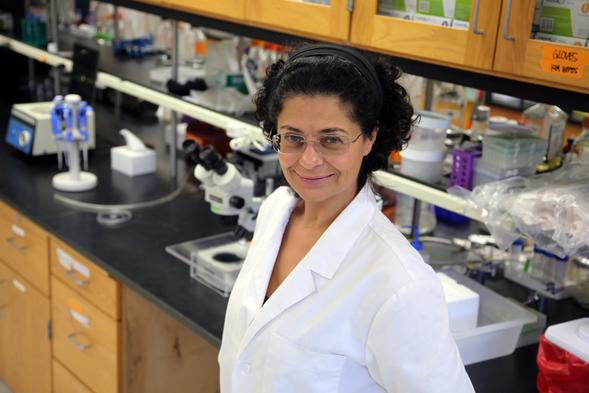Crystallizing the Mysteries of the Cell
SDSU biochemist Manal Swairjo sought out crystals for fun as a youngster, but now uses crystallography to better understand cells and improve medicine.

“My personal motto is, if you can do physics, you can do anything.”
Growing up in the Hawally neighborhood of Kuwait City, Manal Swairjo was a bit of an outsider in two ways. She belonged to a refugee family that fled Gaza, Palestine, when she was a baby, and she, her parents and five siblings were sometimes treated like second-class citizens. But she was also an outsider in that she spent much of her childhood outdoors, exploring the Arabian Desert. Her parents were both science teachers, and her geologist father would show her how to dig up fossils and petrified wood, how to determine the hardness of rocks and minerals.
“In a way, I grew up without a country,” she said. “Instead, we had our education to count on.”
Giant excavators used to build new freeways out into the desert would unearth geodes big enough for the young Swairjo to sit inside. She fell in love with exploring the natural world and, above all, with crystals.
Today, Swairjo works on crystals of a much, much smaller nature. Earlier this year, she joined San Diego State University as an associate professor of biochemistry and brought with her a rich research program looking into the microscopic crystalline structure of a particular piece of cellular machinery called transfer RNA, or tRNA.
Following her stars
At Kuwait University, Swairjo double-majored in math and physics and at first wanted to study astrophysics. She was accepted into a program at Boston University and in 1989, she moved there to start her life in the United States.
“Cowboy movies and Star Trek were the extent of my exposure to American culture,” Swairjo said. “I was a huge Trekkie.”
So Boston came as a bit of a shock to her. She experienced snow for the first time in her life during her first Halloween there, and caught some light teasing for her excitement about it. But with the help of a close group of other international students, she soon found her place. It was also during this first year that she decided to give up astrophysics and pursue biophysics instead. Swairjo hadn’t studied biology since high school, but she relished the idea of challenging herself and doing work with more terrestrial impact.
“My personal motto is, if you can do physics, you can do anything,” she said.
Within biophysics, she gravitated toward crystallography, using X-rays to explore the atomic architecture of parts of the cell. Looking back, she sees how her childhood spent digging up geodes with her father shaped her career, but she never realized it at the time.
“My father had an immense influence on me, but I didn’t even realize that until after I had earned my Ph.D.,” she said.
Working with “nonsense”
After earning her doctorate, Swairjo worked as a staff scientist at The Scripps Research Institute in San Diego, then as an assistant professor at Western University of Health Sciences in Pomona, California. At the latter institution, she began researching tRNA, an adaptor molecule that links messenger RNA sequence with amino acid sequence during the creation of new proteins.
She’s particularly interested in naturally-occurring modifications to the tRNA’s building blocks called nuncleosides. Without these modifications, the decoding of the genetic information can go wrong, resulting in “nonsense proteins” that are responsible for several neurodegenerative diseases, as well as mitochondrial disease.
Interestingly, the series of chemical reactions that leads to these modifications is also similar to the enzyme pathway used by harmful, drug-resistant bacteria such as MRSA and Neisseria gonorrhoeae to produce a vitamin called folate. If you can prevent the bacteria from making this vitamin, you can kill it in its tracks.
With funding from both the National Institutes of Health and the National Science Foundation, Swairjo and her colleagues are using X-ray crystallography to learn more about the microscopic construction of tRNA in hopes of designing drugs that can target the folate pathway, offering new weapons in the fight against bacterial disease. It’s a bit like designing a dummy key to fit into a lock so the real key won’t fit.
“When you know the structure of the active site of the enzyme, you can try to put a small molecule in the active site to block it,” Swairjo explained. “It’s easier to design an effective inhibitor when you have some knowledge about the shape of the active site.”
Dream big
Even though she’s relatively new to campus, Swairjo is already finding her groove. She has implemented a problem-based learning model into her classroom teaching and has seen students respond with enthusiasm to what might otherwise be yawn-inducing lectures. She is also an investigator with SDSU’s highly productive Viral Information Institute, helping to introduce structure-based drug design to antiviral research.
In a few years’ time, Swairjo hopes she will have made her mark in several different ways. One way would be to develop an enzyme inhibitor that becomes a promising drug candidate. Another would be to discover a novel protein fold or some new chemical property in the ocean. And the last would be to continue the crystalline legacy she inherited from her father.
“I would like to graduate a crystallography Ph.D. student,” she said. “That’s also been a dream.”



